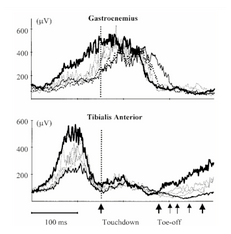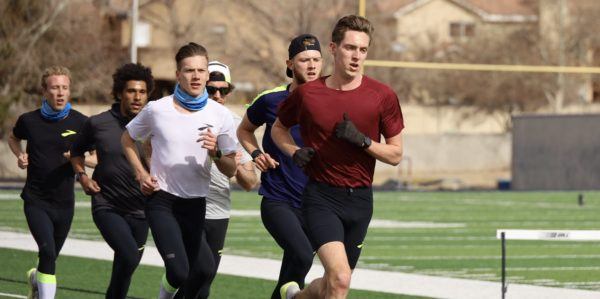As the first point of contact between the body and the ground, the importance of the feet and ankles cannot be overstated, and we will, therefore, spend some time going over this rule in more detail.
Perhaps the easiest way to envision the importance of flexed ankles is to ask how effective you would be at squatting 1.5-2.5x your body weight while standing on your toes. It goes without saying that you can produce more force with the entirety of your foot on the ground, and a lower leg in an ‘accelerative’ position, relative to the foot (i.e. dorsi-flexed).
If we look at the initial ground contact phase, limb angular velocity translates into force from an aggressive ground strike and stiff ground contact — limiting excessive collapse at the ankle and knee in the sagittal plane (and also at the hip in the frontal plane – in not having excess pelvic obliquity [side to side movement] as the runner strikes and collapses into the ground. Again, some compliance is always going to occur – and is necessary, but excessive compliance is not a good thing; it will prolong ground contact times, and generally decrease speed.
It is not only upon ground-strike where a flexed ankle is important though; it is important throughout the gait cycle, as we will describe below.
Active ankle flexion from the moment of toe-off is coached by many track and field coaches – “Toes up, knees up” is a common cue, albeit one that may not be the most appropriate for all at all times. The act of producing and maintaining dorsiflexion from toe-off through to the moment prior to ground strike results in a number of mechanical advantages, including:
First: Placing the ankle in an anatomically relative neutral position, which is the most stable position due to co-activation of agonists and antagonists. When a joint is loaded in a neutral position, the agonist and antagonist will co-contract – thus providing the greatest amount of dynamic stability (force closure). The action of maintaining dorsiflexion thus positions the foot (specifically, the talocrural joint) in an anatomically more stable position – allowing better management of the large forces created at ground strike.
Second: Maintenance of tension through the gastrocnemius during swing phase, assisting the hamstrings in managing eccentric deceleration of the lower leg. In addition to reducing overall load to the hamstrings, the combined eccentric action of the hamstrings and gastroc tendons creates increased elastic potential through the extensor chain, which is significantly reduced if plantar flexion occurs early.
Third: Facilitation of the stretch-shortening cycle of the gastroc-soleus and musculature of the deep compartment. As the gastroc, soleus, and musculature of the deep compartment are pre-tensioned, the intrafusal fibers (muscle spindles) are sensitive to further stretch. Upon ground contact, the sudden increased elastic strain will stimulate a reflexive contraction of the plantarflexors.
Given that reflexive contraction is faster than volitional activation, the action of creating pre-stretch will lead to shorter ground contact times (GCT) with a more forceful, faster push off. With increased articular stability (discussed above) and faster time to contraction (reflexive), the athlete will more efficiently harness elastic return developed through the myofascial system (in the form of elastic strain energy through series elastic components). Efficiency of elastic return reduces the biochemical demands of energy production.
It has been postulated that utilization of tendon elastic strain energy is enhanced with increased running speed – which is consistent with findings that have highlighted the discrepancy in mechanical work done and metabolic energy expenditure during locomotion. Specifically, the efficiency of generating positive work is greater than what would be predicted from muscle contraction alone, with this disparity increasing steadily with running speed.
Lai et al. (2014)6 wanted to determine the overall contribution of elastic strain energy mediated through the achilles (and extensor chain) to force development with increasing running speed. What these researchers found was that tendon elastic strain energy provided a greater contribution to MTU (muscle tendon unit) positive work than muscle fiber work for both the gastroc and soleus at all running speeds (see figure K below).
Furthermore, the contribution of tendon elastic strain energy increased with faster running. The authors illustrated that as velocity increased, the gastrocnemius and soleus muscle fibers behaved increasingly in an isometric fashion. The more stable the talocrural joint is at ground strike, the more efficient the tendon elastic component contribution to positive work becomes.
The bottom line is, when observing movement, we need to ensure close evaluation of ankle flexion through the gait cycle.

Early plantar flexion will have negative consequences on efficiency, and will greatly increase braking forces.
The action of active dorsiflexion instead serves to maintain the optimal postural position of the foot and talocrural joint, which results in the previously discussed mechanical benefits. As with anywhere else in the body, a loss of postural alignment will result in decrements in performance – as well as increased loads into specific tissues based on how the changes alter load distribution.
The quality of dorsiflexion is observed throughout the entirety of the gait cycle — restriction of dorsiflexion, sustained, passive plantar flexion after toe-off, or premature plantar flexion through swing phase are possible mechanical errors that can occur.
As a coach, we must develop strategies to assist an athlete in correcting these faults – and it is important to point out that not all of these faults are technical in nature. Sometimes, athletes will not dorsiflex simply because they cannot. They lack the appropriate dorsiflexion range of motion in the first place. Remember – an athlete’s movement is governed by their internal constraints. There are a number of potential anatomical reasons why an athlete will have restricted dorsiflexion. Recognizing these issues, and in what phase of gait they occur, helps us to determine the most appropriate input or intervention to employ.
One more thing as it relates to lower leg kinematics — it is important to understand there is a degree of co-activation prior to initial touch-down.

Kyrolainen and colleagues7 felt that this “pre-landing activity seems to be important for regulating the landing stiffness” and “increased coactivity of agonist and antagonist muscles just before and after touchdown suggests increased knee and ankle joint stiffness in the beginning of the contact phase.”
This co-activation of agonist and antagonist muscles prior to touch down acts to dynamically stabilize the ankle joint just prior to initial ground contact, and then also in the beginning of the ground contact phase to dynamically stabilize the ankle and knee joints.

